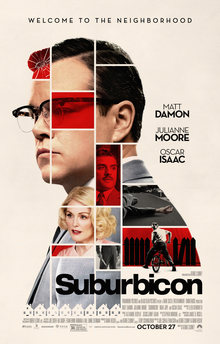
Theatrical release poster
|
|
by Peter J. O’Connell
Suburbicon. Released:
Oct. 2017. Runtime: 104 mins. MPAA Rating: R for violence, language, and some
sexuality.
George Clooney is a fine actor, including in four films made
by the Coen brothers. He also has directed six films, several quite good. And
he is a noted advocate for liberal causes. Now we have Suburbicon. Clooney doesn’t appear in this film, but he has
directed it himself, co-written it with the Coen brothers and Grant Heslov, and
co-produced it.
The movie is a dramedy attempting to weave together three
elements: film noir, satirical/semi-surrealistic comedy, and social justice
concerns. The first two of these elements are characteristics of Coen brothers’
films. The last reflects Clooney’s own interests. Unfortunately, the attempt to
interweave the three elements fails. At best they are only loosely looped
together. In fact, we might say that the whole movie is rather loopy. Its
exaggerated portrayal of stereotypical characters and its stilted dialogue may,
perhaps, be an attempt to “make things clear by overstating,” but that approach
here is off-putting rather than clarifying.
The eponymous setting of the movie is a Levittown-like community
in 1959. The family-friendly environment in Suburbicon, however, turns
distinctly unfriendly when the town’s first blacks—the Mayers family—move in
and are subject to violent harassment by mobs of white residents. The family’s
only friend is Nicky (Noah Jupe), the young son of Gardner (Matt Damon) and
Rose Lodge (Julianne Moore) next-door neighbors of the Mayers family. Nicky
plays with young Andy Mayers (Tony Espinosa), despite the ordeal being
undergone by Mr. and Mrs. Mayers (Leith M. Burke and Karimah Westbrook).
While Suburbicon’s racist white residents feel invaded by
the peaceable black family, the Lodge “lodge” in the suburban “Garden of Eden” undergoes
a seeming home invasion by two violent thugs, who kill Rose. Margaret, Rose’s
twin sister (also played by Julianne Moore, natch), then moves in with Nicky
and Gardner, with whom she has sex, while debt-ridden Gardner attempts to
collect an insurance policy on Rose’s life. He also attempts to fend off the
demands of the ostensible home invaders (Alex Hassell and Glenn Fleshler) for payment.
You see, Gardner actually hired the two to kill Rose. Moreover, Gardner and
Margaret also have to deal with a swarmily assertive insurance investigator
(Oscar Isaac), who has his own agenda.
In the meantime, poor Nicky, feeling that things are going
out of control but not knowing why, starts to seclude himself in his room.
Eventually, as events reach a climax in a night of horrendous violence, Nicky
begins to see his own father and aunt inside the home as posing an even greater
danger to him than the two criminals from outside.
As mentioned earlier, the racist incidents and what’s going
on with the Lodges never really mesh. Damon and Moore, usually A-list thesps,
rate only a C here. Their attempts to portray their cartoonish characters fall
flat. Glenn Fleshler and Oscar Isaac are much better but can’t save the film.
Noah Jupe as Nicky is good, but certain aspects of his characterization may
make Connecticut audience members somewhat uneasy by their slight resemblance
to behavior of Newtown’s Adam Lanza.
Overall, Suburbicon
attempts to depict the iconic American dream of the suburbs as, in effect, a
nightmarish “con.” Have we seen this concept before? We sure have—in Blue Velvet (1986) and Pleasantville (1998) and American Beauty (1999) and Revolutionary Road (2008), just to name
a few out of a multitude. Yo, Hollywood, give it a break! (Remember, people who
live in glass houses shouldn’t throw stones.)
“Footnote” to the
Film: The racist violence directed at the black family may seem one of the
most exaggerated aspects of Suburbicon.
Sad to say, it is one of the least. The actual historical incident of
horrendous harassment reflected in the film occurred in Levittown,
Pennsylvania, in 1957.
